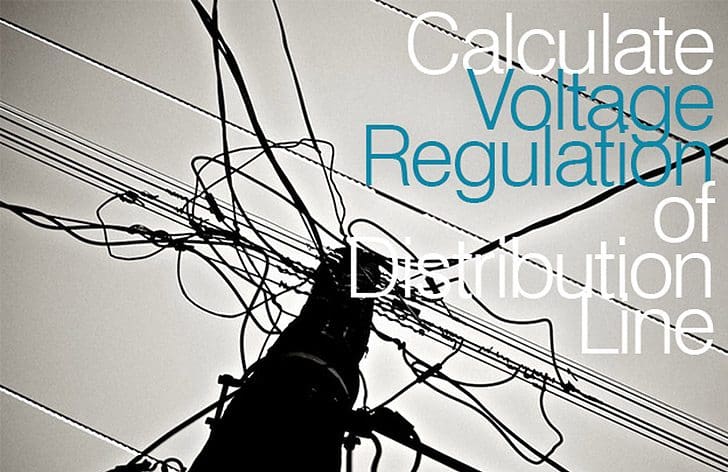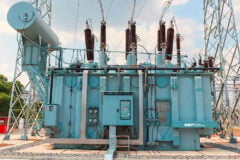Voltage regulation
- Introduction to voltage regulation
- Voltage Regulation for 11KV, 22KV, 33KV Overhead Line
- Permissible Voltage Regulation (As per REC)
- Voltage Regulation Values
- Required Size of Capacitor
- Optimum location of capacitors
- Voltage Rise due to Capacitor installation
- Calculate % Voltage Regulation of Distribution Line

Introduction to voltage regulation
Voltage (load) regulation is to maintain a fixed voltage under different load.Voltage regulation is limiting factor to decide the size of either conductor or type of insulation.
In circuit current need to be lower than this in order to keep the voltage drop within permissible values. The high voltage circuit should be carried as far as possible so that the secondary circuit have small voltage drop.
Voltage Regulation for 11KV, 22KV, 33KV Overhead Line
% Voltage Regulation = (1.06 x P x L x PF) / (LDF x RC x DF)
Where:
P – Total Power in KVA
L – Total Length of Line from Power Sending to Power Receiving in KM.
PF – Power Factor in p.u
RC – Regulation Constant (KVA-KM) per 1% drop.
RC = (KV x KV x 10) / ( RCosΦ + XSinΦ)
LDF – Load Distribution Factor.
LDF = 2 for uniformly distributed Load on Feeder.
LDF > 2 If Load is skewed toward the Power Transformer.
LDF = 1 To 2 If Load is skewed toward the Tail end of Feeder.
DF – Diversity Factor in p.u
Permissible Voltage Regulation (As per REC)
Maximum Voltage Regulation at any Point of Distribution Line | |||
| Part of Distribution System | Urban Area (%) | Suburban Area (%) | Rural Area (%) |
| Up to Transformer | 2.5 | 2.5 | 2.5 |
| Up to Secondary Main | 3 | 2 | 0.0 |
| Up to Service Drop | 0.5 | 0.5 | 0.5 |
| Total | 6.0 | 5.0 | 3.0 |
Voltage Regulation Values
The voltage variations in 33 kV and 11kV feeders should not exceed the following limits at the farthest end under peak load conditions and normal system operation regime.
- Above 33kV (-) 12.5% to (+) 10%.
- Up to 33kV (-) 9.0% to (+) 6.0%.
- Low voltage (-) 6.0% to (+) 6.0%
In case it is difficult to achieve the desired voltage especially in Rural areas, then 11/0.433 kV distribution transformers(in place of normal 11/0.4 kV DT’s) may be used in these areas.
Required Size of Capacitor
Size of capacitor for improvement of the Power Factor from Cos ø1 to Cos ø2 is:
Required size of Capacitor (Kvar) = KVA1 (Sin ø1 – [Cos ø1 / Cos ø2] x Sin ø2)
Where KVA1 is Original KVA.
Optimum location of capacitors
L = [1 – (KVARC / 2 KVARL) x (2n – 1)]
Where:
L – distance in per unit along the line from sub-station.
KVARC – Size of capacitor bank
KVARL – KVAR loading of line
n – relative position of capacitor bank along the feeder from substation if the total capacitance is to be divided into more than one Bank along the line. If all capacitance is put in one Bank than values of n=1.
Voltage Rise due to Capacitor installation:
% Voltage Rise = (KVAR(Cap) x Lx X) / 10 x Vx2
Where:
KVAR (Cap) – Capacitor KVAR
X – Reactance per phase
L – Length of Line (mile)
V – Phase to phase voltage in kilovolts
Calculate % Voltage Regulation of Distribution Line
Calculate Voltage drop and % Voltage Regulation at Trail end of following 11 KV Distribution system:
- System have ACSR DOG Conductor (AI 6/4.72, GI7/1.57)
- Current Capacity of ACSR Conductor = 205Amp,
- Resistance = 0.2792Ω and Reactance = 0 Ω,
Permissible limit of % Voltage Regulation at Trail end is 5%.

Method-1 (Distance Base)
Voltage Drop = ( (√3x(RCosΦ+XSinΦ)x I ) / (No of Conductor/Phase x1000))x Length of Line
Voltage drop at Load A
- Load Current at Point A (I) = KW / 1.732xVoltxP.F
- Load Current at Point A (I) =1500 / 1.732x11000x0.8 = 98 Amp.
- Required No of conductor / Phase =98 / 205 =0.47 Amp =1 No
- Voltage Drop at Point A = ( (√3x(RCosΦ+XSinΦ)xI ) / (No of Conductor/Phase x1000))x Length of Line
- Voltage Drop at Point A =((1.732x (0.272×0.8+0×0.6)x98) / 1×1000)x1500) = 57 Volt
- Receiving end Voltage at Point A = Sending end Volt-Voltage Drop= (1100-57) = 10943 Volt.
- % Voltage Regulation at Point A = ((Sending end Volt-Receiving end Volt) / Receiving end Volt) x100
- % Voltage Regulation at Point A = ((11000-10943) / 10943 )x100 = 0.52%
- % Voltage Regulation at Point A =0.52 %
Voltage drop at Load B
- Load Current at Point B (I) = KW / 1.732xVoltxP.F
- Load Current at Point B (I) =1800 / 1.732x11000x0.8 = 118 Amp.
- Distance from source= 1500+1800=3300 Meter.
- Voltage Drop at Point B = ( (√3x(RCosΦ+XSinΦ)xI ) / (No of Conductor/Phase x1000))x Length of Line
- Voltage Drop at Point B =((1.732x (0.272×0.8+0×0.6)x98) / 1×1000)x3300) = 266 Volt
- Receiving end Voltage at Point B = Sending end Volt-Voltage Drop= (1100-266) = 10734 Volt.
- % Voltage Regulation at Point B= ((Sending end Volt-Receiving end Volt) / Receiving end Volt) x100
- % Voltage Regulation at Point B= ((11000-10734) / 10734 )x100 = 2.48%
- % Voltage Regulation at Point B =2.48 %
Voltage drop at Load C
- Load Current at Point C (I) = KW / 1.732xVoltxP.F
- Load Current at Point C (I) =2000 / 1.732x11000x0.8 = 131 Amp
- Distance from source= 1500+1800+2000=5300 Meter.
- Voltage Drop at Point C = ( (√3x(RCosΦ+XSinΦ)xI ) / (No of Conductor/Phase x1000))x Length of Line
- Voltage Drop at Point C =((1.732x (0.272×0.8+0×0.6)x98) / 1×1000)x5300) = 269 Volt
- Receiving end Voltage at Point C = Sending end Volt-Voltage Drop= (1100-269) = 10731 Volt.
- % Voltage Regulation at Point C= ((Sending end Volt-Receiving end Volt) / Receiving end Volt) x100
- % Voltage Regulation at Point C= ((11000-10731) / 10731 )x100 = 2.51%
- % Voltage Regulation at Point C =2.51 %
Here Trail end Point % Voltage Regulation is 2.51% which is in permissible limit.
Method-2 (Load Base)
% Voltage Regulation =(I x (RcosǾ+XsinǾ)x Length ) / No of Cond.per Phase xV (P-N))x100
Voltage drop at Load A
- Load Current at Point A (I) = KW / 1.732xVoltxP.F
- Load Current at Point A (I) =1500 / 1.732x11000x0.8 = 98 Amp.
- Distance from source= 1.500 Km.
- Required No of conductor / Phase =98 / 205 =0.47 Amp =1 No
- Voltage Drop at Point A = (I x (RcosǾ+XsinǾ)x Length ) / V (Phase-Neutral))x100
- Voltage Drop at Point A =((98x(0.272×0.8+0×0.6)x1.5) / 1×6351) = 0.52%
- % Voltage Regulation at Point A =0.52 %
Voltage drop at Load B
- Load Current at Point B (I) = KW / 1.732xVoltxP.F
- Load Current at Point B (I) =1800 / 1.732x11000x0.8 = 118 Amp.
- Distance from source= 1500+1800=3.3Km.
- Required No of conductor / Phase =118 / 205 =0.57 Amp =1 No
- Voltage Drop at Point B = (I x (RcosǾ+XsinǾ)x Length ) / V (Phase-Neutral))x100
- Voltage Drop at Point B =((118x(0.272×0.8+0×0.6)x3.3)/1×6351) = 1.36%
- % Voltage Regulation at Point A =1.36 %
Voltage drop at Load C
- Load Current at Point C (I) = KW / 1.732xVoltxP.F
- Load Current at Point C (I) =2000 / 1.732x11000x0.8 = 131Amp.
- Distance from source= 1500+1800+2000=5.3Km.
- Required No of conductor / Phase =131/205 =0.64 Amp =1 No
- Voltage Drop at Point C = (I x (RcosǾ+XsinǾ)x Length ) / V (Phase-Neutral))x100
- Voltage Drop at Point C =((131x(0.272×0.8+0×0.6)x5.3)/1×6351) = 2.44%
- % Voltage Regulation at Point A =2.44 %
Here Trail end Point % Voltage Regulation is 2.44% which is in permissible limit.











Dear Sir,
In your above example you have taken following considerations
1. ACSR DOG conductor
2. Resistance=0.2792 Ohm
3. Reactance= 0 Ohm
4. Line current at load point-A=98 Amp
5. Cos Ø=0.8
6. Sin Ø=0.6
I want to calculate voltage drop at point-a with following parameters
1. ACSR DOG conductor
2. Resistance=0.2792 Ohm
3. Reactance= 0 Ohm
4. Line current at load point-A =98 Amp
5. Cos Ø=0
6. Sin Ø=1
In this case
Voltage drop=98 x (0.2792×0 + 0x1) =0 Volt
Or
If Cos Ø=0.01 then voltage drop with 98 Amp load would be very small
I am confused, kindly guide pl.
I want to know the voltage regulation for a short 33 kV line with the following parameters
Power 5 MW
line length 14 km
Transmission Voltage 33 kv
Conductor Panther
I worked out % regulation with formula (Vs-Vr/Vr.
Vr=Vs-losses at full load current.
Voltage Regulation = 1.4 %, kindly look it if correct
I want to design a 33kV single circuit radiating using 100mm AAC from a 60MVA 132/33kV to a distance of 140km.
I have the problem of controlling the Voltage Regulation of this 33kV line.
how do I determine the capacity of voltage regulator to use on the secondary side [11kV] of a transformer which is 15MVA capacity
Sir what is VR constant of dog conductor
Good day,
1. If I am pulling the 5600 MVA @ 0.98 PF on 11kV system and the distance from main sub to my MV sub is around 1.5KM what size of voltage regulators do I need to install to balance my incoming voltage to the plant
How 3rd harmonics are mitigated in tertiary winding, delta connected.
The answer is pending since 2015. Why no body has turned back with a comprehensive reply,including Jignesh Parmar.
Hello Ghazanfar Ali Khan, you posted this message back in 2017, are you still waiting for an answer from a question posted in 2015? Have you come to the conclusion that you are not going to get an answer here? Its ok, have a cookie and everything will be fine.
One 11 KV HT line feeder is required to provide power supply to the sub divided 85 Nos. industrial plots. Though these plots are not yet sold but considering the futuristic requirement of the power supply of the individual plot holder, an electrification scheme is required to be passed from DHBVN as it is technically not feasible to get power supply from the DHBVN. The total minimum load as per the norms of the dhbvn is 3915 kv, hence we need to apply for the sanctioning of the load. Could anyone suggest, how the demand factor / diversification factor is taken and what would be the load required for applying.
As per my calculation the load is : 3910 divided by 0.9 = 4344 kva
Demand factor would = 3910 x .625 = 2443.75 kva or 2.45 mva approx.
Request confirm whether the demand factor 0.625 will be divided or multiplied to get the total load?
How third harmonics are mitigated by tertiary winding?
sir
i am working in Electricity Department Silvassa. recently i have made calculation as per above method which is as under . kindly guide me is it true?
% Voltage Regulation of Distribution Line
A
66/11KV Athal s/s end Load 250KVA=225KW at PF.-09
Calculate Voltage drop and % Voltage Regulation at Trail end of following 11 KV Distribution system:
• System have ACSR DOG Conductor (AI 6/4.72, GI7/1.57) ATHAL FEEDER II
• Current Capacity of ACSR Conductor = 300Amp,
• Resistance = 0.2792Ω and Reactance = 0 Ω,
Permissible limit of % Voltage Regulation at Trail end is 5%.
Load at point A=250KVA
Taking P.F-0.9 of system factor
Load =250 X 0.9=225KW
Length of Load Point from Athal S/s=1.5KM=1500Mtr
Method- (Distance Base)
Voltage Drop = ( (√3x(RCosΦ+XSinΦ)x I ) / (No of Conductor/Phase x1000))x Length of Line
Voltage drop at Load A
• Load Current at Point A (I) = KW / 1.732xVoltxP.F
• Load Current at Point A (I) =225 / 1.732x11000x0.99 = 13.12 Amp.
• Required No of conductor / Phase =13.12 / 300 =0.044 Amp =1 No
• Voltage Drop at Point A = ( (√3x(RCosΦ+XSinΦ)xI ) / (No of Conductor/Phase x1000))x Length of Line
• Voltage Drop at Point A =((1.732x (0.272×0.99+0×0.141)x13.12) / 1×1000)x1500) = 9.21 Volt
• Receiving end Voltage at Point A = Sending end Volt-Voltage Drop= (11000-9.21) = 10990.79 Volt.
• % Voltage Regulation at Point A = ((Sending end Volt-Receiving end Volt) / Receiving end Volt) x100
• % Voltage Regulation at Point A = ((11000-10990.79) / 10990.79 )x100 = 0.084%
• % Voltage Regulation at Point A =0.084 %
correct he
sir we facing probem of 33kv line fault at mtabu clouds before monsoon flesh over the linearc devlop betwwen conductor gi pin of pin insulator
What is the longest distance an 11KV line can cover before you upgrade to 33KV line.
We are using 11KV line for the inner city. We are trying to move our generation machinery to a site that is 7 kms away from the city. Some of our staff are saying we should upgrade to a 33KV line for the distance. Is that acceptable. Or should we stick to the 11KV line we use for our inner city distribution.
In other words, does it mean a higher resistance for the 11KV line to justify the 33KV line.
Thanks;
Mohamed A Farah
Sompower Co.
how can i calculate 22KV cable voltage drop ??
Load Current at Point B (I) = KW / 1.732xVoltxP.F
Load Current at Point B (I) =1800 / 1.732x11000x0.8 = 118 Amp.
Distance from source= 1500+1800=3.3Km.
Required No of conductor / Phase =118 / 205 =0.57 Amp =1 No
Voltage Drop at Point B = (I x (RcosǾ+XsinǾ)x Length ) / V (Phase-Neutral))x100
Voltage Drop at Point B =((118x(0.272×0.8+0×0.6)x3.3)/1×6351) = 1.36%
% Voltage Regulation at Point A =1.36 %
How you cal. 6351 value
Dear sir
I have question . Why we choose 5 percent for voltage regulation , I mean i khow there is a standard but the question is what is the idea behind this standard.
thanks a lot.
Dear Sir,
Could you please share the method/formulae for the voltage drop calculation for overhead LT line feeders.
How its possible Voltage drop proper calculation?
Dear Sir, i want to calculate the voltage drop of an overhead line using DOG Conductor of length around 3000 meter and load around 400 KW.
When i m calculating the voltage drop per line then it is over permissible (5%).
Total load of Line = 400 KW
Total length of line = 3000 meter
Transformer capacity = 630 KVA.
Pls guide me for make it under permissible.
I would like to pull power from a 33kv line to my camp 17km away. I am looking at a installing a 200Kva Transformer, 3 phase, 380V
1/ What size CROSS SECTION mm of AAC Aluminium Overhead cable would I require?
2/ Would I be able to connect other transformers upto 400Kva, in Total?
Can you give calculation of Voltage Drop of LV system having 2 or 3 run Parallel Power Cable connection ?
Sir,
LT CABLE VOL.DROP FORMULA IS AS BELOW.
% V.D = 1.732 × LOAD CURRENT × LENGTH × ( CABLE RESISTANCE × COS PHI + CABLE REACTANCE × SIN PHI ) ×100 ÷ NO OF RUNS × 415 × 1000
If any other queries in above formula contact me on above mail.
Dear sir,
In calculating voltage drop at the point B, the load current is 118 Amps,(in your example).But while calculating the voltage drop at the point B,you have taken the current value of point A( 98Amps). is that correct..can you explain…
what is maximum loading in 100 KVA and 63 KVA DTR in HP?
At what voltage level?
I just presently left my banking job to return to field of engineering. Your work on this site has been a tremendous refresher for me and even much more. I just want to say thank you for being part of those helping my confidence of finding a place in the field.
However, there’s still much for me to cover just keep up the good work.
jobo3889@gmail.com
Buenos días Dr Jignesh Parmar
Es usted muy gentil con su publicación. Sin embargo, agradezco por favor resolverme las siguientes inquietudes:
1. Indicarme la razón por la cual, en los ejemplos de regulación, no se acumuló en la carga A, la carga B y C, teniendo en cuenta que se debería acumular el momento eléctrico al momento de cálculo.
2. Indicarme por favor bibliografía adicional (normatividad) para este tipo de cálculo.
Gracias Dr
dear sir!
with due to respect i want to say that you done a fantastic job on this portal and its very helpful to all engineers,technician and all people who related to electrical engineering field.
at last my one request to you that give me more info about the interconnecting transformer ICT using auto transformer, please!
rest is fine and thanking you
GAURAV SINGH RANA
gsrana89025@gmail.com
Dear Sir,
It is more useful datas.
Many more thanks & grateful to you.